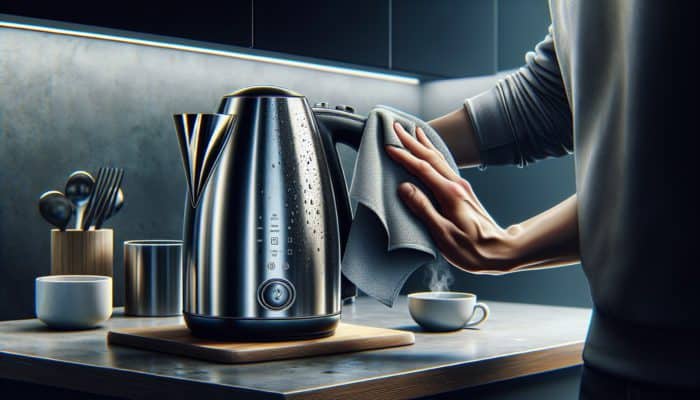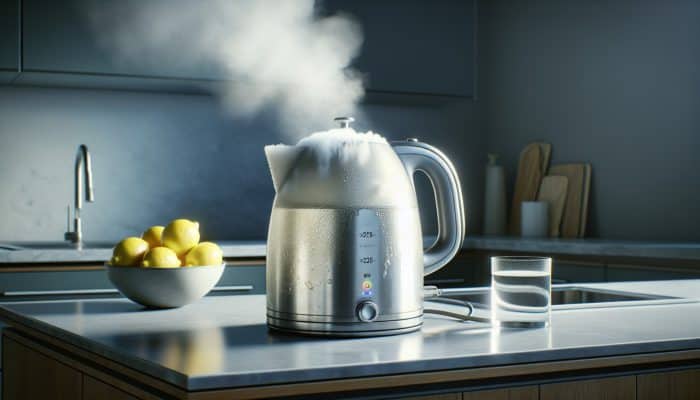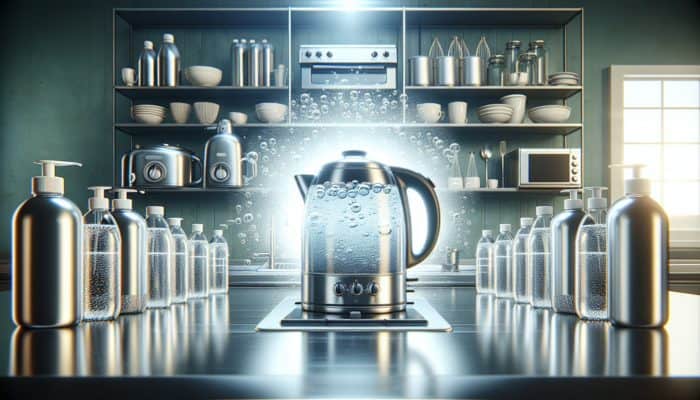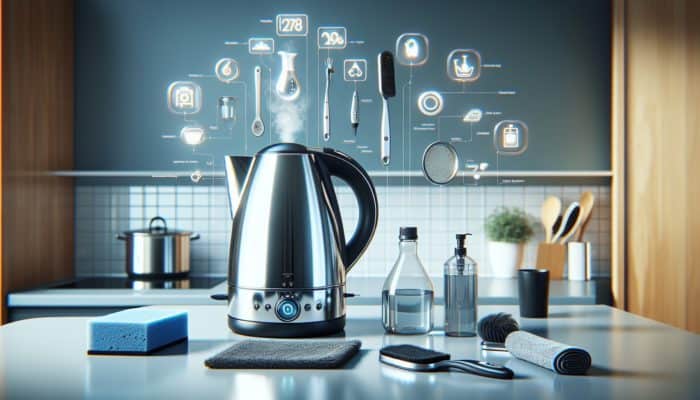Essential Cleaning Procedures for Your Electric Kettle
Daily Exterior Wipe Down to Maintain Aesthetic Appeal

How to Maintain Your Electric Kettle: To ensure your electric kettle remains in immaculate condition, start with a crucial daily habit: a wipe down of the exterior. This straightforward yet vital task can significantly extend the lifespan of your appliance while keeping its appearance fresh and new. Use a damp cloth to clean the exterior surfaces of the kettle gently every day. This routine effectively removes dust, fingerprints, and any grime that may accumulate over time. By keeping the kettle's surface clean, you not only boost its visual appeal but also prevent the accumulation of dirt that could lead to more intensive cleaning requirements later on.
Every time you use your kettle, steam and moisture can accumulate on its exterior, particularly if you live in a humid area. Thus, performing this daily wipe-down becomes increasingly critical. A clean kettle not only enhances the visual aspect of your kitchen but also reflects your meticulousness in maintaining your appliances. Remember, the exterior is often the first thing that visitors notice, so a spotless kettle contributes to an overall welcoming atmosphere in your home and demonstrates your hospitality.
Consider enhancing this simple daily cleaning ritual by occasionally using a mild detergent. Just a drop on your cloth can elevate your cleaning efforts, giving your kettle a gleaming finish that shines brilliantly, regardless of its material or model. With a clean surface, your kettle will not only look attractive but also function better, free from the distractions of dust or unsightly stains.
Weekly Interior Cleaning for Optimal Performance
The interior of your kettle plays a pivotal role in determining the quality of the water you brew. To ensure optimal performance and taste, regular interior cleaning is essential. A tried-and-true method for effectively descaling and deodorising your kettle is the combination of vinegar and water. Mix equal parts of vinegar and water, filling the kettle to about half full.
Boil this solution and allow it to sit for an hour before emptying it. This method effectively eliminates limescale and mineral buildup that can negatively affect the flavour of your hot beverages. Consistently cleaning the interior not only preserves the kettle’s functionality but also ensures that each cup of tea or coffee you prepare remains fresh and delightful.
Depending on the hardness of your water, you may need to adjust the frequency of this cleaning process. In areas with particularly hard water, consider performing this cleaning twice a week to ensure optimal results. After descaling, thoroughly rinse the kettle with clean water to ensure no vinegar residue lingers, as this can influence the flavour of your drinks.
Your weekly cleaning routine should also incorporate a careful inspection of the interior for any signs of wear or damage. By adhering to this cleaning schedule, you promote the longevity of your kettle, ensuring it remains a dependable companion in your daily routine.
Monthly Deep Cleaning for Comprehensive Care
Every month, dedicate time to give your electric kettle a deep clean—a spa day for your appliance. This process focuses on tackling stubborn stains and mineral deposits that a quick cleaning might overlook. Baking soda is an excellent ally in this endeavour, known for its natural cleaning properties. Start by filling the kettle with water and adding several tablespoons of baking soda. Bring this mixture to a boil and then let it sit for about 30 minutes.
This method not only combats tough stains but also neutralises any lingering odours. It’s a simple yet effective technique that rejuvenates your kettle's interior back to its original pristine state. Be sure to rinse thoroughly after the cleaning cycle to eliminate any residual taste in your beverages.
In addition to using baking soda, consider employing an old toothbrush to scrub any particularly stubborn areas, especially around the spout or heating element. These spots can accumulate grime that often goes unnoticed. Regularly performing a deep clean will ensure that your kettle operates efficiently and your brews taste exceptional.
A clean kettle translates to cleaner water, which can significantly enhance the health benefits of your tea or coffee. By dedicating this time each month to thorough cleaning, you extend the life of your kettle, ensuring it remains a beloved staple in your kitchen for many years to come.
Effective Descaling Techniques for Your Electric Kettle

Vinegar Solution Method for Efficient Descaling
When it comes to effectively descaling your electric kettle, the vinegar solution method is a reliable approach. This technique utilises the natural acidity of vinegar to break down limescale and other mineral deposits that accumulate over time. Begin by filling your kettle with equal parts of water and vinegar, ensuring you have enough to cover any visible scale.
Bring this mixture to a boil, allowing it to reach a rolling boil before switching off the heat. Allow it to sit for at least an hour; this duration enables the vinegar to penetrate the limescale effectively. After an hour, discard the solution and rinse the kettle thoroughly with clean water. This process not only cleans the kettle but also neutralises any vinegar odour, ensuring that your next brew is free from unwanted smells.
Using this method is not only effective but also environmentally friendly. Many households already have vinegar readily available, making it a cost-effective solution for maintaining your appliance. Moreover, you can adjust the vinegar solution method based on the severity of the limescale; increase the concentration of vinegar for more stubborn deposits.
Regularly monitoring the cleanliness of your kettle is crucial. If you observe that limescale builds up quickly, consider implementing this descaling method bi-weekly. This proactive approach not only enhances your kettle's performance but also extends its lifespan, ensuring it continues to serve you well for many years.
Citric Acid Approach for a Fresh Alternative
For those seeking an alternative to vinegar, the citric acid approach is an excellent option for descaling your electric kettle. Citric acid, naturally found in citrus fruits, is notably effective in dissolving mineral deposits without the strong odour associated with vinegar. To get started, dissolve a tablespoon of citric acid in a full kettle of water.
Bring the solution to a boil and simmer it for approximately 15-20 minutes. After this, please switch off the kettle and let it cool. Once cooled, carefully empty the kettle and rinse it thoroughly with clean water. This method not only cleans but also leaves your kettle smelling fresh, free from any harsh chemical scents.
The citric acid approach is especially beneficial for individuals sensitive to strong smells or those living in areas with hard water. Its natural composition makes it an appealing choice for environmentally conscious consumers. Furthermore, citric acid is readily available in supermarkets and health food stores, making it a convenient cleaning solution.
Regularly employing the citric acid technique can significantly reduce scale buildup, ensuring your kettle remains in optimal condition and consistently delivers clean, crisp water for every cup. As with other descaling methods, adjust the frequency according to your usage and local water conditions.
Utilising Commercial Descalers for Convenience

For those who prefer convenience, commercial descalers are specifically formulated to effectively tackle limescale and mineral deposits. When using a commercial descaler, carefully follow the manufacturer's instructions to achieve optimal results. Typically, these products require you to add a specified amount of descaler to the kettle, fill it with water, and then boil the mixture.
This method is incredibly advantageous for individuals who may not have the time or inclination to prepare natural alternatives. Commercial descalers are designed to work quickly and efficiently, often producing results within minutes. They are also formulated to minimise any risk of damage to the kettle, making them a safe choice for regular maintenance.
In addition to their effectiveness, many commercial descalers come in user-friendly packaging, complete with clear instructions suitable for both beginners and seasoned users. For those living in areas with particularly hard water, incorporating a commercial descaler into your cleaning routine can save time and effort, ensuring your kettle operates at its optimal level.
However, it’s wise to alternate between commercial and natural descaling methods. This variety ensures your kettle remains in excellent condition while allowing you to benefit from the unique qualities of both methods. By maintaining a consistent descaling routine with commercial products, you will enhance your kettle's performance and longevity.
Baking Soda Technique for Gentle Descaling
The baking soda technique provides a gentle yet highly effective method for descaling your electric kettle. This versatile ingredient is renowned for its cleaning capabilities and is a staple in many households. Begin by filling your kettle with water and adding a few tablespoons of baking soda. Bring this solution to a boil, allowing the heat to activate the baking soda's properties.
After boiling, switch off the kettle and let the solution sit for approximately 30 minutes. The baking soda works to dissolve mineral deposits and neutralise any unpleasant odours, making it a dual-purpose cleaner. After the waiting period, carefully dispose of the solution and rinse the kettle thoroughly with clean water to eliminate any remaining baking soda residue.
This method is particularly beneficial for those seeking an environmentally friendly cleaning solution. Baking soda is non-toxic and safe for your health, making it an ideal choice for families and individuals concerned about chemical exposure. Furthermore, it is readily available and affordable, providing a cost-effective cleaning option.
Incorporating the baking soda technique into your maintenance routine can significantly enhance the longevity of your kettle. It reduces the need for more aggressive cleaning strategies and helps keep your appliance in excellent working order. For optimal results, consider alternating between baking soda and other descaling methods to ensure comprehensive care for your electric kettle.
Comprehensive Exterior Maintenance for Your Kettle
Polishing the Surface for Lasting Shine
The exterior of your electric kettle is more than just a protective shell; it reflects your style and the care you take with your appliances. To maintain its elegant appearance, regular polishing is essential. Use a soft cloth along with a mild detergent to wipe down the surface, ensuring you remove any stains or smudges that may detract from its beauty.
Over time, kettles can accumulate fingerprints, water stains, and dust, particularly if they are frequently used or placed in a busy kitchen. By dedicating a few moments each week to polish the surface, you can maintain its shine and prevent the buildup of grime. This simple act not only enhances the kettle’s aesthetic appeal but also ensures that it remains a stylish addition to your kitchen décor.
For stainless steel kettles, consider using a dedicated stainless steel cleaner. This product provides a protective layer that helps prevent tarnishing and scratching, ensuring your kettle maintains its appearance. By investing in the right cleaning supplies, you’ll ensure your kettle remains a stunning focal point in your kitchen.
In environments with high humidity or coastal climates, extra care should be taken to polish the surface on a regular basis to prevent damage. Moisture in the air can lead to corrosion, and a good polish acts as a barrier against the elements, keeping your kettle looking new and functioning effectively. Remember, a well-maintained exterior not only enhances the kitchen's appearance but also signifies your commitment to quality and care in your kitchen.
Effectively Handling Scratches for a Flawless Finish
Scratches on your electric kettle can be unsightly, but with a little attention, they can be managed effectively. Minor scratches can often be buffed out using a small amount of metal polish. Apply a tiny amount to a soft cloth and gently rub the scratched area in a circular motion. This technique can help restore the kettle's surface and reduce the visibility of imperfections.
For deeper scratches, you may need to consider a more intensive approach. Fine-grade sandpaper can be used to carefully sand down the scratched area, followed by polishing to restore the shine. Always exercise caution during this process, as excessive sanding can lead to a dull finish or damage the kettle's surface.
Regularly inspecting your kettle for scratches and addressing them promptly is crucial for maintaining its aesthetic appeal. A well-maintained kettle enhances your kitchen's overall ambience and reflects your attention to detail. If your kettle is a focal point in your kitchen, ensure it consistently presents itself in the best possible light.
To prevent future scratches, be mindful of where you place your kettle and what surfaces it comes into contact with. Using coasters or mats can help mitigate the risk of scratches from rough countertop surfaces. By taking these preventive measures, you'll maintain the pristine appearance of your electric kettle for years.
Preventing Corrosion for Longevity
Corrosion can silently threaten your electric kettle, especially in humid environments. Prevention is key to ensuring that your appliance remains in top condition. After cleaning your kettle, always ensure it is thoroughly dried. Moisture can promote corrosion, particularly in areas where water accumulates, such as around the lid and base.
In coastal areas, the combination of salt and humidity can accelerate the corrosion process. To combat this, consider applying a thin layer of food-grade oil to the exterior surface of your kettle. This protective layer acts as a barrier against moisture, helping to prevent rust and corrosion from taking hold.
Regularly inspecting your kettle for signs of corrosion is also essential. Check for any discolouration or flaking in the metal, particularly around the base and spout. If you notice any signs of corrosion, address them promptly to prevent further damage. Simple preventive measures, such as ensuring your kettle is dry after use and stored in a cool, dry place, can significantly extend its lifespan.
In addition to these steps, consider using silica gel packets in the storage area of your kettle to absorb excess moisture. By taking proactive measures to prevent corrosion, you can ensure that your electric kettle continues to serve you well, providing you with hot water and beverages for years to come.
Effectively Removing Stains for a Pristine Look
Stains on the exterior of your electric kettle can detract from its elegance, but with the right approach, they can be effectively removed. Begin by using a non-abrasive cleaner suitable for your kettle's material. Apply a small amount to a soft cloth and gently rub the stained area, taking care not to scratch the surface.
Stains may arise from various sources, including spills or residue from food and drinks. Regular cleaning can help prevent stains from setting in; however, if they do occur, acting quickly is key. For stubborn stains, consider using a paste made from baking soda and water. Apply this paste to the stain, let it sit for a while, and then gently scrub using a soft cloth.
Always rinse the kettle thoroughly after cleaning to ensure no cleaning products remain on the surface. This step is crucial, as residues from cleaners can seep into your drinks, altering their taste. By keeping the exterior of your kettle clean and stain-free, you maintain its aesthetic appeal and ensure it remains a stylish addition to your kitchen.
In addition to regular cleaning, consider implementing preventive measures, such as using coasters or trays beneath the kettle to catch spills. By being proactive and attentive to detail, you can keep your electric kettle looking and functioning well for years.
Protecting Against Rust for Optimal Performance
Rust is a common concern for metal appliances, particularly in coastal regions where salt and humidity can cause significant damage. Protecting your electric kettle from rust involves a combination of regular maintenance and preventive measures. Begin by thoroughly cleaning the kettle, ensuring it is completely dry before storage. Any remaining moisture can lead to the formation of rust.
Applying a thin layer of food-grade oil to the kettle's exterior can serve as an effective deterrent against rust. This layer creates a barrier against moisture and protects the metal surface. When applying oil, use a soft cloth to ensure an even coat, taking care to cover all exposed areas.
Additionally, consider the environment in which your kettle is stored. Keeping it in a dry, well-ventilated area can significantly reduce the risk of rust. Avoid storing it in enclosed spaces where humidity can build up. By being mindful of storage conditions and regularly inspecting for signs of rust, you can keep your kettle in excellent condition.
If you notice rust forming, address it immediately by using a fine steel wool pad to scrub away the rust gently. Afterwards, rinse thoroughly and dry completely. Following this process will help you maintain the integrity of your electric kettle, ensuring it continues to provide you with hot water for your beverages.
Comprehensive Care for the Lid and Spout
Thoroughly Cleaning the Lid for Hygiene
The lid of your electric kettle is often overlooked during routine cleaning, yet it plays a crucial role in both functionality and hygiene. To clean the lid effectively, remove it from the kettle and soak it in warm, soapy water. This method helps loosen any built-up grime or stains.
After soaking, use a soft sponge or cloth to scrub the lid gently, paying special attention to crevices where dirt may accumulate. It’s crucial to ensure that all parts of the lid are thoroughly cleaned, as residue can affect the taste of your beverages. Rinse the lid under running water to remove any soap residue before reattaching it to the kettle.
For those living in humid environments, the lid can also become a breeding ground for mould if not cleaned regularly. To avoid this, consider using a disinfectant spray after cleaning to eliminate any remaining bacteria. Ensure the lid is completely dry before reassembly to prevent moisture buildup.
Regularly cleaning the lid not only maintains hygiene but also ensures the kettle operates efficiently, as a clean lid helps create a proper seal during boiling. By dedicating time to this often-neglected component, you enhance both the functionality and longevity of your electric kettle.
Unclogging the Spout for Optimal Flow
Clogged spouts can disrupt the flow of water in your electric kettle, leading to frustration during use. A small brush or pipe cleaner can be your best ally when it comes to unclogging the spout. These tools can easily reach the narrow opening and remove any buildup causing blockages.
Start by inspecting the spout for any visible obstructions. If you see scale or debris, gently insert your brush or pipe cleaner and work it back and forth to dislodge the blockage. After unclogging, rinse the spout thoroughly with warm water to ensure no particles remain.
Maintaining a clean spout is essential not only for efficiency but also for hygiene. Water can stagnate in a blocked spout, leading to potential health risks. Regularly checking and unclogging the spout will enhance your kettle’s performance, ensuring every pour is smooth and effortless.
If you reside in an area with hard water, consider incorporating regular descaling into your routine to prevent buildup in the spout. By being proactive in caring for this part of your kettle, you’ll ensure it remains functional and effective for all your hot beverage needs.
Lubricating Hinges for Smooth Operation
The hinges of your kettle lid often go unnoticed during cleaning routines, yet they are crucial for smooth operation. Over time, these hinges can become stiff or squeaky, affecting the kettle's functionality. To ensure they operate smoothly, a drop of food-grade lubricant can work wonders.
Begin by applying a small amount of lubricant to the hinges. Gently open and close the lid several times to work the lubricant into the mechanisms. This not only keeps the hinges operating smoothly but also prevents wear that can lead to malfunction over time.
Regular lubrication is especially important for kettles that are frequently used, as constant movement can wear down the hinges. By incorporating this simple step into your maintenance routine, you can extend the life of your kettle and ensure it remains a reliable part of your kitchen arsenal.
In environments with high humidity, lubricating the hinges can also help prevent rust from forming. By taking the time to care for these small components, you not only maintain the kettle's functionality but also extend its overall lifespan.
Filter Maintenance for Quality Water
Removing and Cleaning the Filter for Freshness
The filter in your electric kettle plays a crucial role in ensuring the quality of the water you boil. Regular maintenance of this component is essential for optimal performance. Begin by carefully removing the filter from the kettle, following the manufacturer's instructions.
Once removed, hold the filter under running water to rinse away any debris or mineral deposits. Consider using a soft brush to gently scrub the filter, particularly if you notice any stubborn buildup. By keeping the filter clean, you enhance the quality of your water, ensuring that every cup of tea or coffee tastes fresh and pure.
In regions with hard water, this cleaning process should be performed weekly to combat the rapid accumulation of scale. Neglecting this step can lead to decreased efficiency and, over time, damage to the kettle.
After cleaning, ensure the filter is completely dry before reattaching it to the kettle. This will prevent moisture retention, which can lead to mould growth. By making filter maintenance a regular part of your routine, you’ll not only enhance the kettle’s performance but also improve the quality of your beverages.
Replacing the Filter for Optimal Functionality
Over time, your kettle's filter will wear out and need to be replaced. Typically, manufacturers recommend replacing the filter every few months, although this interval can vary depending on usage and water quality. Regularly inspecting the filter for any signs of damage or wear is crucial; if you notice any tears, cracks, or significant discolouration, it's time for a new filter.
Replacing the filter not only ensures the quality of your water but also enhances the kettle’s overall efficiency. A worn-out filter can lead to poor water quality, which can adversely affect the taste of your beverages. When purchasing a new filter, ensure that you select the type that is compatible with your specific kettle model.
Keep in mind that some kettles feature built-in filters that are not easily replaceable. In such cases, consult your manufacturer's guidelines for maintenance and replacement options. By staying proactive about filter replacement, you can guarantee your kettle continues to function optimally, providing you with delicious hot beverages.
Incorporating a reminder for filter replacement into your cleaning routine can help ensure that this essential maintenance step doesn’t slip your mind. By prioritising filter care, you enhance both the longevity of your kettle and the quality of your drinks.
Checking for Damage to Maintain Performance
Regular inspections of your kettle's filter are vital for maintaining its functionality. Over time, filters can deteriorate due to wear and tear, resulting in decreased efficiency and potential issues with water quality. During your routine checks, look for any signs of damage, such as cracks or discolouration. If you find any irregularities, it’s best to replace the filter immediately to maintain optimal performance.
In addition to visual inspections, consider conducting water quality tests periodically. This can help identify any contaminants that may be present, indicating that your filter may need replacement sooner than anticipated. By taking a proactive approach to filter maintenance, you can ensure that your electric kettle operates efficiently and provides clean, safe water for your beverages.
Regularly checking for damage not only safeguards the quality of your drinks but also extends the lifespan of your kettle. A compromised filter can lead to issues with the kettle’s heating element and overall functionality, making it crucial to address any signs of wear promptly.
As with other maintenance tasks, establish a schedule for checking your filter. This can be incorporated into your regular cleaning routine, ensuring you remain attentive to this essential component of your kettle.
Proper Storage of the Filter for Longevity
Proper storage of your kettle's filter is essential for prolonging its lifespan and maintaining its effectiveness. When not in use, always store the filter in a dry, cool place. Avoid areas with high humidity or direct sunlight, as these conditions can promote mould growth and degrade the filter material.
If the filter is removable, consider placing it in a dedicated storage container to prevent accidental damage. This is particularly important if you have multiple filters or accessories for your kettle. By keeping the filter safe and secure, you ensure it remains in excellent condition for future use.
In addition to proper storage, consider keeping a record of your filter's lifespan to ensure optimal performance. Many manufacturers provide guidelines on how long filters should last based on usage and water quality. By staying informed, you can anticipate when it's time to replace the filter, ensuring uninterrupted performance of your kettle.
Maintaining proper storage practices for your filter is a simple yet effective way to guarantee your kettle remains functional and efficient. By prioritising this step, you contribute to the overall care of your electric kettle.
Lubricating the Filter for Efficient Operation
Ensuring a proper fit for your kettle's filter is essential for optimal performance. A well-fitted filter not only keeps impurities out but also reduces the risk of leaks during operation. Applying a recommended lubricant to the filter's seals can enhance this fit, ensuring a snug seal that prevents any unwanted water escape.
When lubricating the filter, use food-grade lubricant to ensure safety during operation. A drop of lubricant on each seal will suffice; it's essential not to overdo it, as excess lubricant can attract dirt or impurities. After applying, reattach the filter and check for any movement or looseness. A secure fit will contribute to the overall efficiency of your kettle.
Regular lubrication of the filter seals is particularly important for kettles that are used frequently. By ensuring a proper fit, you enhance the kettle’s ability to produce clean, quality water for your drinks. This proactive maintenance step will not only improve performance but also prolong the lifespan of your kettle.
Incorporate filter lubrication into your regular cleaning routine. This attention to detail will enhance the functionality of your kettle, ensuring that every cup of tea or coffee is brewed to perfection.
Safe Storage and Usage Practices
Guidelines for Proper Storage of Your Kettle
Proper storage of your electric kettle when not in use is crucial for preventing mould and mildew growth. Always store your kettle in a dry area, away from excessive moisture. If your kettle has a removable filter, ensure it is completely dry before storing, as retained moisture can lead to unpleasant odours and potential health risks.
Consider placing your kettle on a dedicated shelf or in a cupboard where it can be protected from dust and other kitchen contaminants. Avoid placing heavy items on top of the kettle, as this can cause damage over time. Proper storage ensures that your kettle remains clean and ready for use whenever you need it.
In addition to keeping the kettle dry, ensure that the electrical cord is neatly stored to prevent tangles and potential damage. A tidy storage arrangement will prolong the life of your kettle and maintain its functionality.
By taking the time to establish proper storage practices, you ensure that your electric kettle remains in excellent condition, ready to provide you with hot water for your favourite beverages at a moment’s notice.
Avoiding Overfilling for Safety
Overfilling your electric kettle can lead to boiling water spilling over, causing potential burns or damage to the appliance. Always be mindful of the maximum fill line indicated inside the kettle. This line indicates the safe capacity for boiling water without risking overflow.
In addition to preventing accidents, adhering to the maximum fill line can enhance the kettle's efficiency. Kettles are designed to heat specific volumes of water quickly, and exceeding this capacity can lead to longer heating times and increased energy consumption.
To further reduce the risk of overfilling, consider pouring water into the kettle from a measuring jug. This will help you accurately gauge the amount of water you’re adding. If you're unsure about how much water to use, always err on the side of caution and fill less rather than more.
By avoiding overfilling, you safeguard your kitchen and ensure your kettle operates efficiently, providing you with hot water whenever you need it without unnecessary risks.
Regular Inspection for Maintenance
Regularly inspecting your electric kettle is essential for identifying signs of wear or damage before they become serious issues. Examine the exterior for any scratches or rust, and check the spout and lid for blockages or damage. A simple visual inspection can help you catch potential problems early, ensuring your kettle remains functional and safe.
Pay special attention to the electrical cord and plug during inspections. Look for fraying or exposed wires, as these can pose significant safety hazards. If you notice any issues, consult the manufacturer's guidelines or a professional for repairs.
In addition to visual inspections, consider regularly testing the kettle's functionality. Ensure that it heats water efficiently and that the automatic shut-off feature operates correctly. By being proactive in your inspections, you extend the lifespan of your kettle and ensure it continues to serve you well.
Develop a routine for these inspections, perhaps aligning them with your cleaning schedule. By committing to regular checks, you enhance the safety and performance of your electric kettle, ensuring it remains a reliable part of your kitchen.
Frequently Asked Questions about Electric Kettle Maintenance
What is the recommended cleaning frequency for my electric kettle?
It’s advisable to perform a daily wipe down, a weekly interior clean with vinegar, and a monthly deep clean using baking soda. This routine will help maintain your kettle's performance and appearance.
Can I substitute lemon juice for vinegar when descaling my kettle?
Yes, lemon juice is a natural descaler due to its acidity and can be effectively used in place of vinegar for descaling your kettle.
What should I do if my kettle has a persistent stain?
For stubborn stains, create a paste of baking soda and water, apply it to the stain, let it sit for a while, and then scrub gently before rinsing thoroughly.
How can I prevent limescale buildup in my kettle?
Regular descaling using vinegar or citric acid is an effective method. Additionally, using filtered water can help reduce mineral buildup.
Is it safe to place my kettle in the dishwasher?
Most electric kettles are not dishwasher safe. Always refer to the manufacturer’s instructions regarding cleaning and maintenance to avoid damage.
How do I determine when to replace the filter in my kettle?
Generally, filters should be replaced every few months or when you notice a reduction in water quality or flow. Check the manufacturer's guidelines for specific recommendations.
What is the best method for storing my kettle?
Store your kettle in a dry place, ensuring it is completely dry before putting it away. Avoid storing it in humid areas to prevent mould growth.
Can I use commercial descalers regularly?
Yes, commercial descalers can be used regularly, but it’s advisable to alternate between commercial and natural methods to maintain a balanced cleaning routine.
What should I do if my kettle starts to develop rust?
If rust is present, scrub it gently with fine steel wool, rinse thoroughly, and dry completely. To prevent future rust, ensure proper cleaning and storage practices are followed.
Why is it important to lubricate the hinges of my kettle?
Lubricating the hinges ensures smooth operation and prevents wear over time. It can also reduce the risk of squeaking and extend the lifespan of your kettle.



I love how you’ve highlighted the importance of a daily wipe-down for electric kettles! It’s such a simple step, yet it truly makes a difference. I recently started this routine, and not only does my kettle look great, but it also feels like I’m taking better care of my kitchen overall. It got me thinking—how often do we apply this same principle to other kitchen appliances? A quick clean can go a long way in preventing buildup and maintaining functionality. Plus, it’s a nice little moment of mindfulness in our busy days. Anyone else have particular cleaning hacks for other appliances?
This post highlights an often-overlooked aspect of appliance care. I’ve found that regular maintenance truly enhances not only the longevity of my electric kettle but also the quality of the water I boil. A clean exterior not only looks good but helps avoid any potential contamination from dust or residue that might otherwise get into our drinks.
Maintaining the exterior of an electric kettle is such a simple yet impactful practice. I can relate to the importance of keeping it clean, especially since I often brew herbal teas that can sometimes leave sticky residues if not wiped down regularly. Over time, I’ve noticed that a quick daily wipe not only keeps the kettle looking good but also makes it easier to tackle deeper cleaning tasks, like descaling. It’s interesting to consider how these small routines contribute to the overall lifespan of our appliances. I wonder if there are specific cleaning agents or techniques that others have found effective for getting rid of water spots or limescale without damaging the surface. Has anyone tried any eco-friendly solutions? I’d love to hear your experiences!